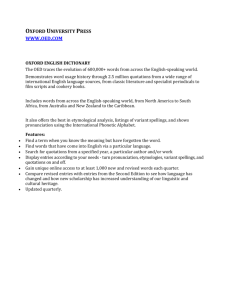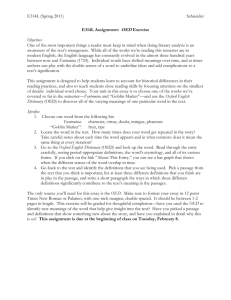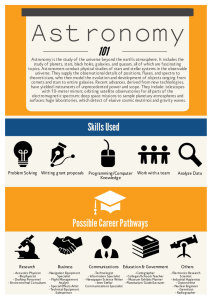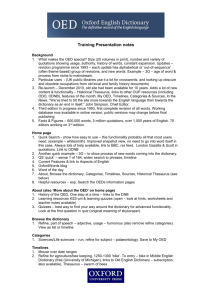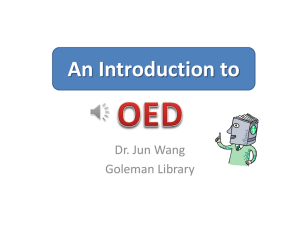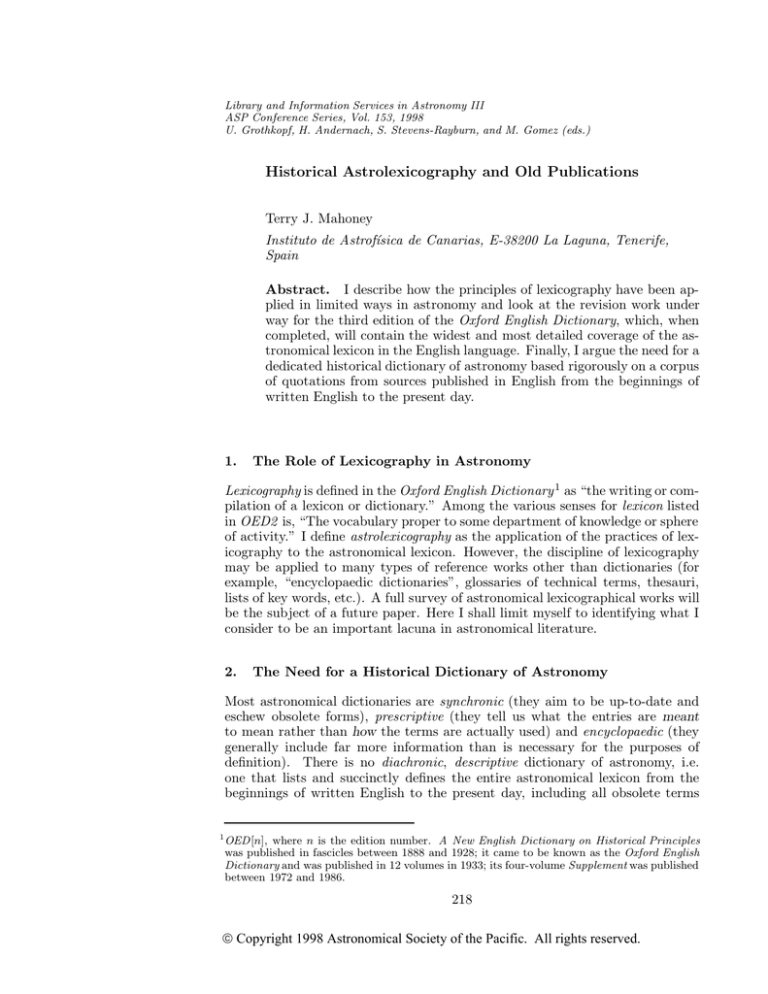
Library and Information Services in Astronomy III
ASP Conference Series, Vol. 153, 1998
U. Grothkopf, H. Andernach, S. Stevens-Rayburn, and M. Gomez (eds.)
Historical Astrolexicography and Old Publications
Terry J. Mahoney
Instituto de Astrofı́sica de Canarias, E-38200 La Laguna, Tenerife,
Spain
Abstract. I describe how the principles of lexicography have been applied in limited ways in astronomy and look at the revision work under
way for the third edition of the Oxford English Dictionary, which, when
completed, will contain the widest and most detailed coverage of the astronomical lexicon in the English language. Finally, I argue the need for a
dedicated historical dictionary of astronomy based rigorously on a corpus
of quotations from sources published in English from the beginnings of
written English to the present day.
1.
The Role of Lexicography in Astronomy
Lexicography is defined in the Oxford English Dictionary 1 as “the writing or compilation of a lexicon or dictionary.” Among the various senses for lexicon listed
in OED2 is, “The vocabulary proper to some department of knowledge or sphere
of activity.” I define astrolexicography as the application of the practices of lexicography to the astronomical lexicon. However, the discipline of lexicography
may be applied to many types of reference works other than dictionaries (for
example, “encyclopaedic dictionaries”, glossaries of technical terms, thesauri,
lists of key words, etc.). A full survey of astronomical lexicographical works will
be the subject of a future paper. Here I shall limit myself to identifying what I
consider to be an important lacuna in astronomical literature.
2.
The Need for a Historical Dictionary of Astronomy
Most astronomical dictionaries are synchronic (they aim to be up-to-date and
eschew obsolete forms), prescriptive (they tell us what the entries are meant
to mean rather than how the terms are actually used) and encyclopaedic (they
generally include far more information than is necessary for the purposes of
definition). There is no diachronic, descriptive dictionary of astronomy, i.e.
one that lists and succinctly defines the entire astronomical lexicon from the
beginnings of written English to the present day, including all obsolete terms
1
OED[n], where n is the edition number. A New English Dictionary on Historical Principles
was published in fascicles between 1888 and 1928; it came to be known as the Oxford English
Dictionary and was published in 12 volumes in 1933; its four-volume Supplement was published
between 1972 and 1986.
218
Copyright 1998 Astronomical Society of the Pacific. All rights reserved.
Historical Astrolexicography and Old Publications
219
and changes of sense. The work that comes closest to providing such coverage
is the OED. The present (second) edition has many gaps in its general scientific
coverage which are now being filled for the third edition2 .
OED2 is the source of most of the historical information about the English
language found in other dictionaries. The OED has as its aim “to present in
alphabetical series the words that have formed the English vocabulary from the
time of earliest records down to the present day, with all relevant facts concerning their form, sense-history, pronunciation, and etymology” (Simpson &
Weiner 1987). That is a fairly stiff challenge and one which the OED compilers
have met admirably. The OED has been criticized for its relatively unrepresentative science coverage (Landau 1989). This problem was partially addressed
in the second edition, but only now, with the new revision programme (under
way since 1995) and the regular publication of volumes in the OED Additions
Series (Simpson & Weiner 1993a,b; Proffitt 1997) is the problem being tackled
in a thorough and systematic way. A considerable investment is being made in
updating and extending the coverage of the astronomical lexicon, and on its completion OED3 will incorporate the widest coverage of astronomical vocabulary
from the dawn of the English language to the present time.
The task of producing a new edition of the OED is twofold. First, there
is the revision of all the entries in OED2 . Secondly, new senses of existing
entries and entirely new entries need to be drafted and incorporated into the
body of the dictionary. Proofs for entries are sent out to specialist advisers,
who check the accuracy of the definitions, and, where necessary, provide further
illustrative quotations (ante-datings are the most important, but sometimes it
is necessary to provide more recent quotations, especially for entries that have
not been revised since the last century!). Staff editors then modify the entry
in the light of the specialists’ comments. Suggestions for new entries come
from many quarters. The principal criterion is frequency of occurrence in print:
the more quotations there are for a new-word candidate, the better its chances
of acceptance for inclusion. Concerning astronomy, the number of new words
(including old words that were left out of earlier editions) that have been drafted,
or are earmarked for drafting, is growing apace, and no realistic estimate of the
eventual size of the astronomical lexicon to be included in OED3 can yet be
made. Meanwhile, new words and senses are being published, in batches of
3000, in the Additions Series (Simpson & Weiner 1993a,b; Proffitt 1997).
In OED2 the coverage of the astronomical lexicon is rather uneven in that a
number of common terms are not in. As an example, comparatively few constellation names are included in OED2 ; this has now been remedied, at least for the
88 “official” IAU constellations, all of which now have entries (both for the full
Latin names and their IAU abbreviations). As an example, Microscopium now
has an entry in its own right with a precise coinage reference to Lacaille in 1752
(the IAU-approved abbreviated form Mic also has an entry). The illustrative
quotations for astronomical entries in OED2 are often fairly easily antedated,
2
The following web sites give further information on progress towards OED3 :
http://www.oed.com/inside (“Inside the OED”), http://www1.oup.co.uk/reference/
(OED Newsletter), and http://proto.oed.com/ (OED online—under development).
There is also: http://www.oup.co.uk/jnls/list/lexico (International Journal of Lexicography).
220
T. J. Mahoney
but this can only be truly remedied by a systematic search of the entire bibliography of astronomy in the English language (i.e. pre-XIV Century to the present
day). Some of the entries have not been revised for over a century; this is being
put right with the present revision programme, which will revise all of the OED
in a uniform manner. A good example of an antedating occurs for Medusa’s
head, which has an earliest quotation dating 1706 in OED2 and 1556 in OED3
(English constellation names are an area that still needs to be charted in detail). The progress of the revision process can be followed in the OED Newsletter,
which is published biannually (available at http://www1.oup.co.uk/reference/).
Astronomical entries (both for revision and new-word entries) are revised
by the Astronomy Adviser who checks that their content is accurate, up to
date and fully covers all senses. An important part of this work is to look
for antedatings of the illustrative quotations (inter- and post-datings can also
occasionally be of use). New quotations are written down on 600 × 400 white slips
and full bibliographical details given. The slip contents are later keyed into
the dictionary database by staff at the OED. The OED is now fully processed
by computer (otherwise certain aspects of revising its more than 21000 threecolumn pages of dense text of OED2 would be a hopelessly unmanageable task
on human timescales); nevertheless, the white slip is an essential way of recording
data for quotations and new entries for the simple reason that it is the most
transportable, silent and user-friendly means of recording written information
and can be used in any library! The word or sense under revision will nearly
always act as a node for further new-entry suggestions (I refer to this as the
nodal approach to corpus building). The drafting of entries (usually done by
staff editors) involves providing, apart from the definition, information on the
etymology, grammatical function and pronunciation of the term and illustrative
quotations.
3.
Is OED3 the Answer for the Astronomical Lexicon?
The OED is a unique work and offers invaluable information to the scholar interested in the development and evolution of the English language. In terms of
astronomy OED3 will provide the best available overall picture of the evolution
of the English astronomical lexicon, but for finer detail a change of scale will
be necessary. The range of spacing between quotations is insufficient for answering, for example, the question of how astronomical terminology varies over
a timescale of less than, say, 50 years or more (although the coverage is quite
adequate for modern terms). The subtleties of the changes in the astronomical
lexicon really need a specialized dictionary based on historical principles which
has more space to devote to a denser coverage of the corpus. For this a dedicated
Historical Dictionary of Astronomy (HDA) is needed.
4.
An Astronomical Corpus in English
Before a historical dictionary can be even considered, a corpus of quotations
illustrative of all known words and senses is required; the compilation of such a
corpus from the entire range of printed matter in the English language pertaining
to astronomy will require an effort even greater than writing the AHD itself.
Historical Astrolexicography and Old Publications
221
Apart from astronomical publications as such, astronomical vocabulary occurs
in a wide range of other publications (works of literature, navigational treatises,
newspaper reports, historical works, etc.). All of this needs to be scanned and
quotations recorded for all types of usages of all astronomical terms. This is
clearly a long-term goal, and the writing of the HDA cannot await its completion.
There are two methods of working towards overall representativeness of the
corpus. First there is the systematically thorough reading programme. This is
the surest way of building a representative corpus, but it is also the most timeconsuming and is better treated as a long-term project aimed at completing an
already existing corpus. The second method is to sample current journals and
books for synchronic vocabulary and to complement this by a judicious sampling
of the literature of past centuries. For historical and some modern astronomical
vocabulary, OED2 already provides a very useful database3 .
The preliminary task of identifying a representative subset of the astronomical lexicon is to compile a wordbase from other astronomical dictionaries
(and the OED for obsolete terms). However, this will yield only a subset of the
true lexicon and, without further research, would look (and rightly!) like mere
plagiarism (see Landau 1989 for an instructive history of English lexicography).
5.
HDA Entries
The HDA should aim to describe the entire English lexicon of relevance to astronomy, from its very earliest beginnings to the present rather than prescribing rules
for “correct” usage. It should also be diachronic rather than synchronic. Above
all, the HDA should give concise definitions, including only such information as
is necessary for the strict purposes of definition. Our knowledge of astronomical
phenomena is constantly evolving; ideas that seem perfectly clear and obvious
to us today may well be totally overturned tomorrow. A historical dictionary
indicates past examples of such vocabulary changes reflecting “paradigm shifts”
(Kuhn 1970) by tagging past senses as obsolete where necessary and recording
all instances of sense changes and multiple meanings (“polysemy”). The HDA
should be designed to appeal to a very wide range of users, from the student of
literature puzzled by a poetical reference to, say, Astraea’s diadem to the professional astronomer who wishes to jog his memory on the meaning of, say, Swan
band. Historians of astronomy would certainly benefit from an exhaustive catalogue of obsolete words and senses in their constant vigilance against committing
that most embarrassing of historical errors, the anachronism. A record of astronomical usage through the centuries will also provide historians with a valuable
chronology of the scientific ideas reflected in the words and senses recorded. The
HDA should provide authoritative information of the first recorded use of every
word and sense in the astronomical lexicon.
3
As a by-product of my work as OED Astronomy Adviser I have also started my own astronomical corpus, which now amounts to several thousand entries. This has necessarily been
built nodally while treating OED entries in alphabetical sequence; however, I have also begun a reading programme with the recently published correspondence of John Flamsteed (see
Forbes et al. 1996, 1997). Already, this reading programme has resulted in some interesting
ante-datings of OED2 entries.
222
T. J. Mahoney
In general, HDA entries should have: i) a highlighted headword; ii) a grammatical function label; iii) an International Phonetic Alphabet pronunciation
guide (perhaps both British and American); iv) pertinent etymological information; v) an indication of currency of use: vi) (for modern terms) an indication of
whether the term is IAU (or similarly) approved vii) a subject label, especially
where the usage is relevant to other fields, such as geology, navigation, literature, etc.; viii) one definition per sense; ix) highlighting of terms cross-referenced
elsewhere in the dictionary; x) illustrative quotations (at least one per decade,
with greater density of coverage for the modern period); xi) tagging of earliest
known occurrence; xii) line drawings where these aid comprehensibility, and xiii)
appendices of tables containing information on present and past nomenclature
systems for planets, stars, nebulae, galaxies, etc. Entries would be arranged
alphanumerically, probably according to a system that is both case and font
sensitive (to allow for commonly used mathematical symbols and variables),
and there should be a thesaurus to indicate interrelations among the entries.
6.
Some Working Rules for Historical Astrolexicography
When drafting definitions for a diachronic dictionary of astronomy, the most
fundamental rule is to define strictly according to the evidence provided in the
quotations. We are interested in how astronomers (and others) use the astronomical lexicon, not in how they think a given term should be used. Hence,
major planet will be found to mean either one of the four gas giants or any
one of the nine principal planets. Individual astronomers may have their own
ideas on what the term ought to mean, but the evidence (and I have plenty)
indicates that both the meanings just given are in current use in astronomical
publications. Similarly, three definitions may be derived for such an apparently
straightforward term as astronomical unit: i) the mean distance of the Earth
from the Sun, ii) by dynamical arguments, a value equal to 1.00000003 times
the mean distance of the Earth from the Sun, and iii) any other physical unit of
measurement (mass, etc.) used in astronomy as a standard quantity.
All quotations must be carefully checked against original copies on paper.
Of course, all quotations would need to be keyed into an electronic database for
ease of manipulation, and of course the computer keyboard is the best place to
start looking for quotation sources, especially in recent research papers. The
news of progress in the project to scan historical astronomical literature for
access on the ADS (Eichhorn & Kurtz 1998) is most welcome and will be of
great assistance to astrolexicographers. Nevertheless, the white slip continues
to play a unique role in historical lexicography. Verified hand copying according
to well defined editorial rules will also ensure homogeneity of treatment of the
entire corpus (which, I repeat, would definitely need to be computerized).
Implicit in all that has been said so far is the need for collections of early
books, journals and, especially for very early material, either manuscripts or
reliable modern editions of pre-twentieth century works. Modern compilations
of historical material need to be examined critically for editorial “improvement”
of the original for the modern reader’s supposed benefit (the Victorians were
great “improvers” in this respect). If, say, Flamsteed is cited, it is preferable
to raise the quotation directly from a source that reflects his original spelling
Historical Astrolexicography and Old Publications
223
and punctuation rather than a more recent, polished version; in this respect the
recent publication of Flamsteed’s entire correspondence by Forbes et al. (1996,
1997) is an extremely valuable lexicographical resource (not to mention its even
greater historical worth). Much of the correspondence of English astronomers
of the 15th and 16th centures is still unpublished and contains valuable lexicographical information. It is vital, from all points of view, that this material be
efficiently and safely archived for future use. Apart from OED2 , there is little
information on how language has been used by scientists in general and on how
their use of language has shaped their approach to science. Astronomy is the
ideal science for such a study since it has been a recognizable discipline for more
than two millenia, whereas physics and chemistry, became recognizable in their
modern guise a mere four or five centuries ago. Astronomy was already a fullyfledged science while the English language was evolving from its Anglo-Saxon
and medieval French roots to become today’s lingua franca of world science. The
English astronomical lexicon is therefore the ideal candidate for a dedicated dictionary of astronomy based on historical principles. Apart from the scholarly
interest of such a work it would also serve as a solid foundation on which to base
all future discussions on terminology and nomenclature.
Acknowledgments. I thank Alan Hughes, Chief Science Editor of the
Oxford English Dictionary, for his help and patience over several years in dealing with my endless queries concerning OED working practice. I must stress,
however, that the views expressed in this article are my own and are not necessarily shared by the editorial staff of the OED.
References
Kurtz, M. J., & Eichhorn, G. 1998, these proceedings, 293
Forbes, E. G., Murdin, L., & Willmoth, F. (eds.) 1996, The Correspondence
of John Flamsteed, First Astronomer Royal, Vol. I (Bristol, Institute of
Physics)
Forbes, E. G., Murdin, L., & Willmoth, F. (eds.) 1997, The Correspondence
of John Flamsteed, First Astronomer Royal, Vol. II (Bristol, Institute of
Physics)
Landau, S. I. 1989, Dictionaries, 2nd. edn. (Cambridge, Cambridge Univ.
Press)
Kuhn, T. 1970 The Structure of Scientific Revolutions, 2nd. edn. (Chicago:
Chicago Univ. Press)
Proffitt, M. 1997, Oxford English Dictionary Additions Series, vol. 3 (Oxford:
Clarendon Press)
Simpson, J. A. & Weiner, E. S. C. 1987, Oxford English Dictionary, 2nd. edn.
(Oxford: Clarendon Press)
Simpson, J., & Weiner, E. 1993a, Oxford English Dictionary Additions Series,
vol. 1 (Oxford: Clarendon Press)
Simpson, J., & Weiner, E. 1993b, Oxford English Dictionary Additions Series,
vol. 2 (Oxford: Clarendon Press)

